
“Kubrick: and beyond the cinema frame”
An in-depth analysis of
2001: A SPACE ODYSSEY
Text copyright © by Rob Ager 2008
(last updates added 2015)
CHAPTER 2
THE MEANING OF THE MONOLITH
Watch the video review or scroll down and read the text. The video covers much of the material contained in this chapter and includes some additional material not found in the text of this article. Full 47 min version of this particular video is available from my digital downloads store
2001: A Space Odyssey - The meaning of the monolith revealed
And here is a 2021 update of the above video
Variations on the same haunting piece of music, taken from Gyorgi Ligetti's Requiem, seem to occur every time an evolutionary step is being taken in 2001. We hear this music when the apes first encounter the monolith in the dawn of man, when the astronauts encounter a second monolith in the Tycho moon crater and when Dave Bowman encounters the third monolith near Jupiter. We are given repeated confirmation that this music is the singing voice of the monolith and that it sings when it is helping its primitive hosts to evolve. During the stargate, which is preceded by shots Jupiter, Ligetti's requiem blends seemlessly into another Ligetti piece called Atmospheres. Atmospheres is heard at the very beginning of the film over a black screen and later repeats during the intermission just before the astronauts do battle with the HAL 9000 computer, again over a black screen. So, why the black screens? The answer can be found by noting one of the key differences between the film and Arthur C Clarke’s original short story, The Sentinel. Clarke described the monolith as a pyramid shaped piece of polished mineral surrounded by a spherical force field. Kubrick, in adapting the story for cinema, changed this to a black rectangular box …. Why? Because the monolith is a representation of the actual wideframe cinema screen, rotated 90 degrees.

So in the films opening and during the intermission, we are not looking at an empty black screen at all. We are looking directly at the surface of the monolith! The monolith is the film screen and it is singing directly at its audience in the same way that the apes and astronauts are entranced by its heavenly voice, not realising that they are being communicated with directly!!! For almost forty years audiences and reviewers across the globe have sat staring at this black singing screen, not realising that they are staring at the monolith. The joke is on us and Kubrick, if he is watching over us, will be laughing and cheering from beyond the infinite. This widescreen two and a half hour presentation of sight and sound is in itself the stargate and we are its subjects. Kubrick is taking us on a psychedelic ride of intellectual evolution and he is demanding that we literally think outside the box! So the term “Space Odyssey” now has a new literal meaning. It refers to the spatial relationship between the screen, the audience and the audience’s surroundings. The following quotes strongly support the "monolith as screen" interpretation.
At one point a private contractor was asked to mold a large block of Lucite. Kubrick was interested in experimenting with projecting images onto its surface (the monolith). The block was cast and received a lot of newspaper coverage about it being the largest casting of plastic ever attempted. The optics weren’t up to Kubrick’s standards, though, and he scrapped the idea. – production of 2001, p280 Stanley Kubrick by Vincent LobruttoIn the sequence where he (Bowman) is being locked outside, and doesn’t have his helmet on, some films are being projected onto his face. It makes no sense, but looks great. - Douglas Trumball discussing special effects for 2001, quoted from p304 Stanley Kubrick by Vincent Lobrutto
Interviewer To take one specific, in the novel the black monolith found by curious man- apes three million years ago does explicit things which it doesn't do in the film. In the movie, it has an apparent catalytic effect which enables the ape to discover how to use a bone as a weapon-tool. In the novel, the slab becomes milky and luminous and we're told it's a testing and teaching device used by higher intelligences to determine if the apes are worth helping. Was that in the original screenplay? When was it cut out of the film?
Kubrick Yes, it was in the original treatment but I eventually decided that to depict the monolith in such an explicit manner would be to run the risk of making it appear no more than an advanced television teaching machine. You can get away with something so literal in print, but I felt that we could create a far more powerful and magical effect by representing it as we did in the film. – Kubrick interviewed by Joseph Gelmis 1969
The last quote in particular is interesting. If the monolith is in fact a symbolic cinema screen then Kubrick's description of it as "an advanced television teaching machine" would be accurate. The so-called "powerful and magical effect" that Kubrick refers to is simply a deep sense of mysteriousness for the audience based upon only communicating the cinema screen connection at a very subtle level. The interviewer even identified another clue about the meaning of the monolith - that in the book it is described as becoming "milky and luminous". the film itself shows a variety of milky and luminous images of the universe immediately after the stargate tunnel.
The most deceiving aspect of the screen association is that for most of the film the monolith is seen standing upright. If it had been depicted horizontally then it wouldn’t have taken long for reviewers to crack this piece of the puzzle. The connection is also more difficult to make because the upright monoliths are slightly too long to fit the widely used 35mm cinema screen exactly. However, looking at 2001's production history we find that the film was originally shot in 70mm Cinerama format and after it's first release using expensive 70mm triple projectors, 2001 was re-released in 35mm format for a wider distribution.The following poster of the film very blatantly communicates the monolith / cinema screen association, by showing three screen shots of the film, one of which is rotated 90 degrees.
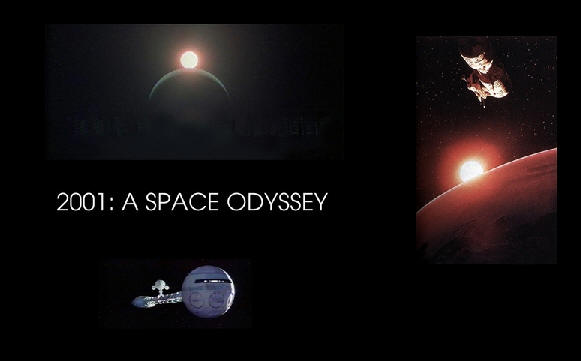
There are literally hundreds of visual clues of the monolith / cinema screen relationship scattered throughout the films visual structure, but I shall concentrate here on the most obvious and undeniable examples. We find several direct hints both before and during the stargate sequence, which has long been one of the most confusing aspects of the film. For the first time in the story we are seeing the monolith freed of its previously vertical stance as it floats around the screen, accompanied by scattered moons and a tormenting piece of music. Notice that at no point does any object on screen pass directly in front or behind this monolith. So we have no indication of its actual size - for all we know it could be a few inches in length or thousands of miles thick.
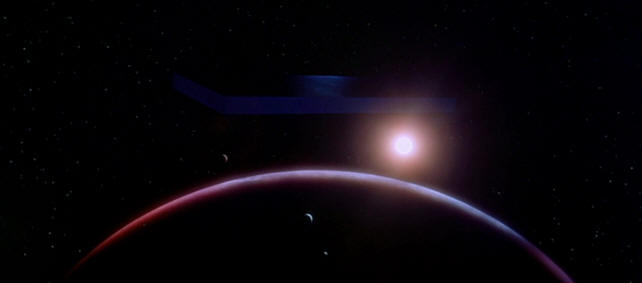
The concept of visual alignment, as seen with Jupiter and its moons, is nothing to do with astronomy or astrology. As the monolith floats about it repeatedly comes close to matching up with the frame of the screen and in some shots the white light reflecting across its surface completely mismatches the light sources of the surrounding sun and moons. As the sun moves on and off screen it causes flares of white light to stretch on and off screen in a similar way to the reflections on the monolith.
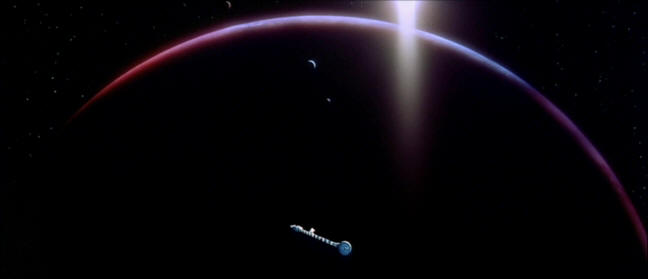
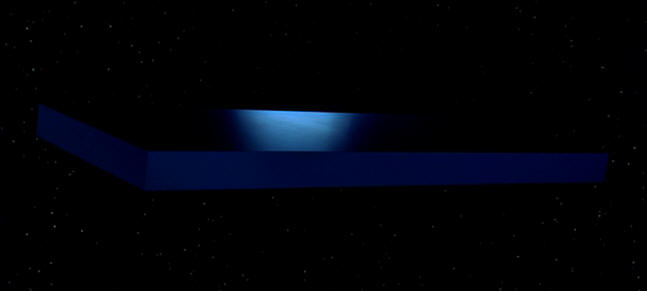
After several minutes of this tormenting imagery we see a shot of Jupiter and its moons suddenly aligned, but the shot is rotated 90 degrees so that Jupiter’s North and South poles are to our left and right. The monolith is in its vertical position, as seen earlier in the film, but due to the 90 degree rotated viewpoint it now appears to be horizontal. Rather than having this horizontal monolith move directly toward us, which would make it perfectly align with the cinema frame and thus make the cinema screen connection absolutely obvious, Kubrick has this monolith tilt backwards until it fades into the blackness of space.
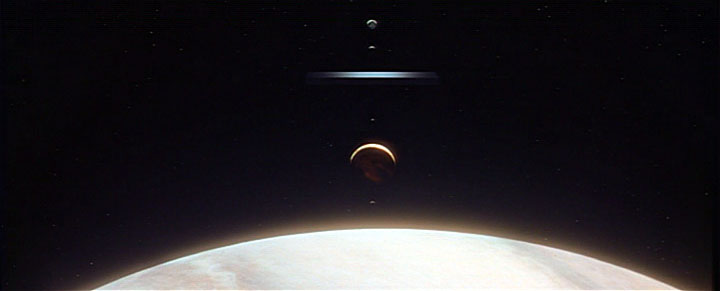
The shot then scrolls up toward where we should see the sun, but we are instead faced with a black screen, just like in the intermission and the film’s opening. The monolith has literally just become the cinema screen and now our stargate voyage can begin. We next see a high speed journey along a vertical horizon of patterned light, leaving both Dave Bowman and the audience tormented and confused as to its meaning. The music intensifies to the point of insanity, adding to our confusion, but then something odd happens. The stargate horizon switches from vertical to horizontal.


This is a hint that if you are going to understand this film consciously then you should be viewing the monolith horizontally. Only then can you make a direct connection between the monolith and the letterbox shape of the cinema screen, hence the films repeated visual themes of rotation and alignment. If you do manage to make this visual connection during the stargate you are then rewarded by the dazzling big bang explosion of consciousness that follows.
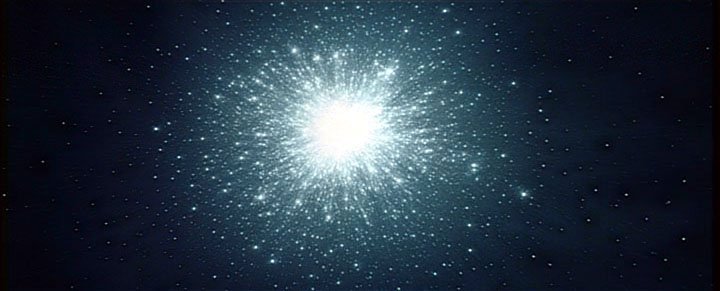
Now if you’re still not convinced that the monolith is a representation of the cinema screen then go back earlier in the film and watch the lunar excavation site landing sequence. During the moon bus descent we see the landing base come into view in the cockpit window. It is in a vertical position and begins slowly rotating into a horizontal position. It is also moving directly toward the computer display screen on the lower left where it will align.
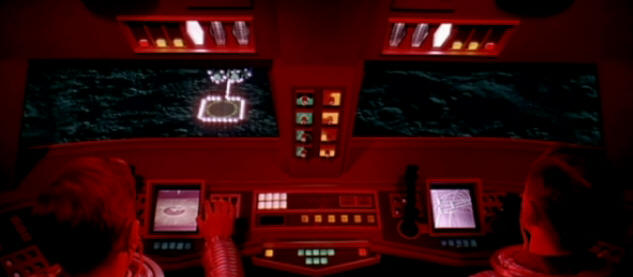
The computer display alternately shows a circular target grid of yellow lines pulsing toward us like the big bang explosion at the end of the stargate. In the middle of this target grid is a rectangular half monolith just below the center of the cross hair.
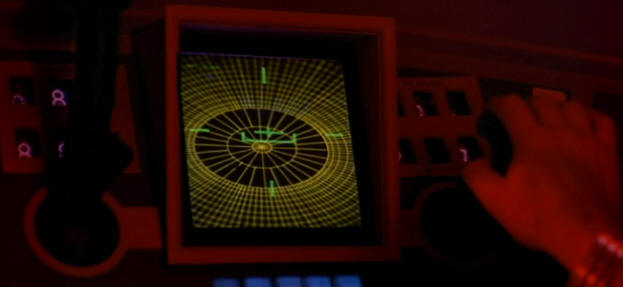
And here is the unbelievably blatant hint that has bypassed our conscious attention for decades … As the landing pad reaches its horizontal position, the missing top half of the monolith rectangle suddenly floats in from the right of the display and matches up with the centre of the cross hair.
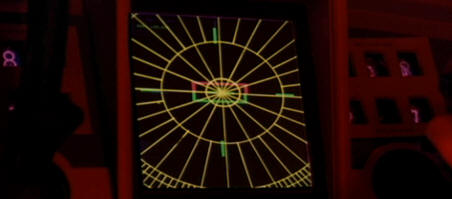
The vertically positioned monolith is completed and the entire cross hair display begins flashing in white, again like the big bang sequence of the stargate. Immediately after this we see the computer display repeated, but this time seen by a man watching the moon bus landing through a large rectangular window. The upper section of the crosshair rectangle floats in again, but just as it’s about to align with the centre the shot cuts away so that the conceptual connection between the rectangle in the computer display and the rectangle of the window is merely suggested.
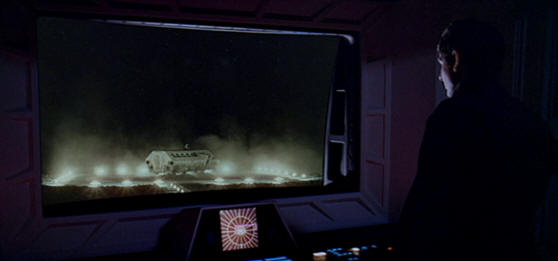
Floyd and his colleagues are also sat in the back of the moon bus puzzling over photos and diagrams. One of the papers shows a spiral target grid with a white monolith rectangle in the lower right corner.

Another computer display along the same lines is featured when Bowman chases Poole’s missing body. Again we have a pulsing circular target display, this time with a monolith type rectangle flashing in the upper right.
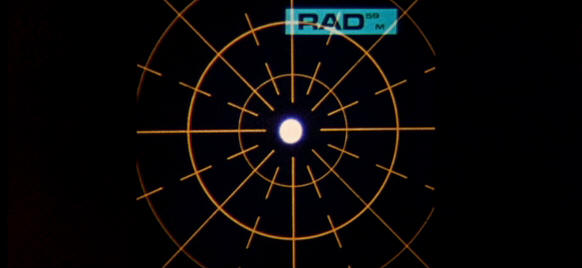
During this pod sequence the yellow target display from the moon bus sequence is several times projected onto Bowman’s face along with a white rectangle floating inwards toward the centre.

If even that doesn’t convince you then look at the coloured light patterns in the horizontal section of the stargate tunnel. Just before the big bang, the stargate pattern fills up with a series of yellow lines and spirals that are very similar to the computer crosshair display in the moon bus.

Even the first lunar landing sequence carries hints of what the monolith is. The spherical craft, carrying Floyd to the moon base, approaches a dome like structure. The dome opens in a star-like pattern, foreshadowing the explosion of consciousness at the end of the stargate, and inside the dome can be seen the outline of a horizontally positioned rectangle.

Another clue is that the door on the back of each spacepod features a prominent sign stating “Caution: Explosive Bolts”.

The door is roughly a vertical monolith shape and on the inside of the door, behind Bowman’s head (visible just as he is about to blast into the vacuum without his helmet), is a horizontal red monolith featuring the same “Explosive Bolts” warning - yet another connection between the letterbox design, the upright monolith and the explosion of the stargate.

Dave holds his breath and faces the correctly positioned red monolith before being blasted into the airlock. This is paralleled in the stargate. His head shakes violently and his complexion turns blue as if he is holding his breath.
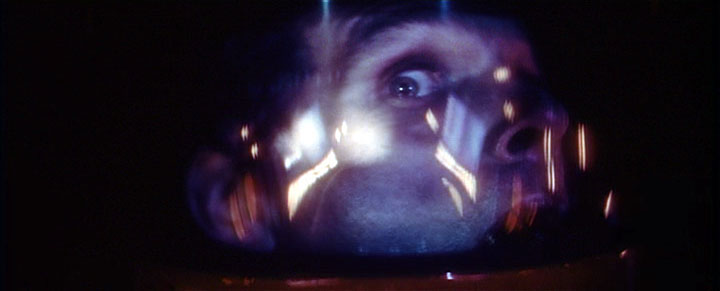
These clues are absolutely no accident. They are exactly the kind of thing Kubrick was referring to when he described the film’s messages as being visually encoded, but the sophistication with which he created these visual associations is so unusual and such a unique directing talent that hardly anybody has ever managed to unravel the monolith’s meaning in nearly forty years. There are so many hints of what the monolith is, but unless you think outside of the films surface narrative you simply cannot crack the puzzle. You are stuck in the box. And by showing us close ups of an eye during the stargate, Kubrick is shouting at us to LOOK at the visual clues, which he has offered in so much abundance.
My first review of 2001 was posted on youtube in early 2007. It gave a basic explanation of the monolith / cinema screen connection, but didn’t delve into the other subjects that we’re going to explore in this expanded review. Within a couple of months after my original review was posted some "unofficial" iphone commercials appeared on youtube that explicitly show the monolith both as a mobile phone and a cinema screen. Perhaps the makers of these ads had either seen my videos or they had cracked the monolith puzzle for themselves. They've since been removed from youtube, but I managed to save copies of them first. You can download them below.
In addition to the all these examples of visual encoding there are some interesting facts on the IMDB Trivia page for 2001 that support this interpretation of the monolith.
"When the film was sold to British TV, Stanley Kubrick urged that it be shown in "letterbox" format, with a black area at the top and bottom of the screen. The BBC complained that while this was fine for dialogue sequences, viewers would become confused when the scene shifted to outer space. The BBC's solution, used during the first TV presentation, was to add fake stars to the black areas above and below the picture area. Bitterly opposed by Kubrick, this disastrous experiment was never repeated."
"When Stanley Kubrick learned that his film would have an intermission in most cinemas (as this happened in most films that length) he not only ordered where the intermission took place, but had his film's composer record specific music for the intermission, and requested that the theatre be plunged into darkness for a minute before the film restarted."
The monolith / screen connection is a mind-blowingly original cinematic concept, but as we shall see 2001’s symbolism doesn’t stop there. What we have done so far is to merely unlock a door through which we can explore the film’s hidden narratives, of which there are many, but before we continue, let’s first identify some of the basic building blocks of Kubrick’s unique style of visually encoded meaning.